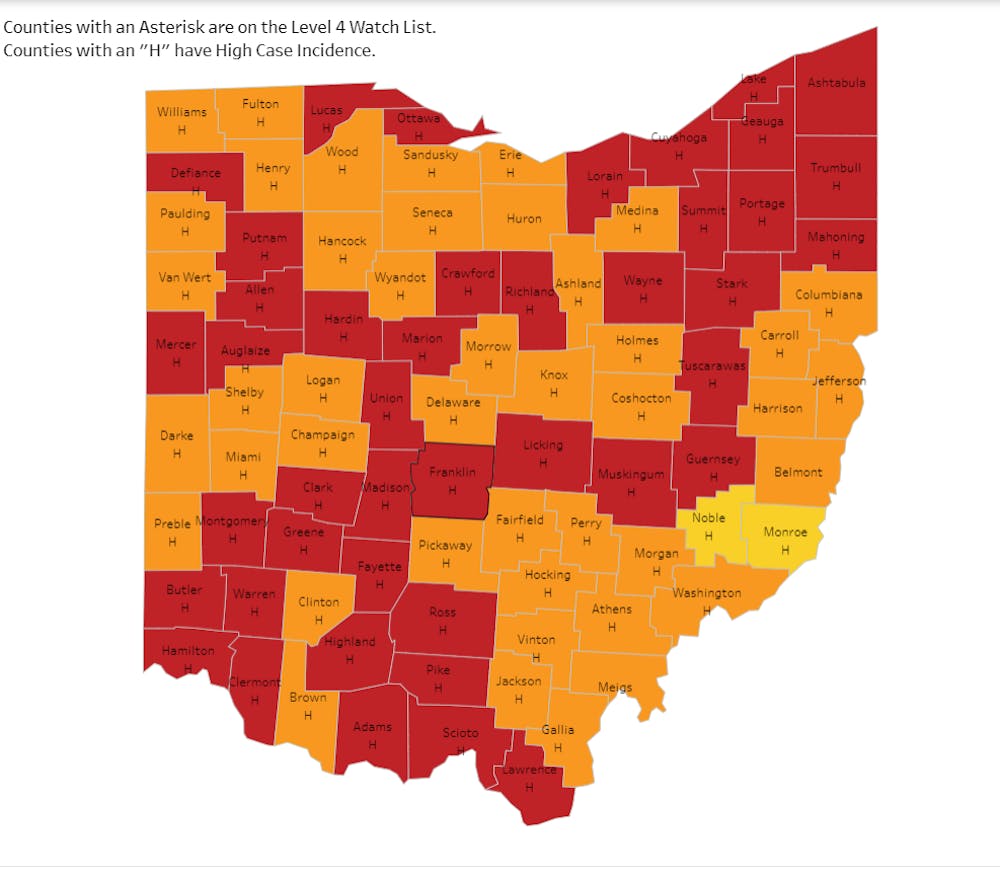For weeks, Butler County has hovered on the edge of Level Four Purple, the highest risk level for COVID-19, according to the Ohio Public Health Advisory System. Official state guidance recommends residents at this level leave their homes only for essential supplies and services.
Butler has been at Level Three Red since Oct. 15. While still below Level Four, the current level is indicative of “very high exposure and spread” of COVID-19 according to the Ohio Department of Health.
Despite the risk of moving to the highest level, Jayne Brownell, vice president for student life, said students shouldn’t expect too many changes on campus.
“Right now, we are not being told we need to change what we’re doing,” Brownell said. “As of right now, I believe we would continue [in-person classes] because we have seen absolutely no spread within the classrooms.”
Brownell said Ohio’s county levels are advisory, not compulsory. With only 16 new cases in the past week and 95% of residence hall floors reporting no new cases at all, Miami’s own four-level structure appears to be working.
The state of COVID-19 at Miami doesn’t directly reflect the state of COVID-19 in Butler County. While Miami makes up nearly a quarter of all cumulative cases in Butler, the university is responsible for less than 10% of active cases in the past two weeks.
Philip Smith, an assistant professor in the department of kinesiology and health, wrote in an email to The Miami Student that whether Butler County goes to Purple might directly relate to how students conducted themselves on Halloween.
“What we are seeing right now is a rise in cases throughout the county that is not attributable to cases at Miami University,” Smith wrote. “This could change — if Halloween weekend is a super spreader event and results in an outbreak on campus, we could be the factor that pushes Butler County into Purple.”
Experts in the Ohio Department of Health (ODH) use seven indicators to determine county levels. Butler is currently flagged in three of them: new cases per capita, non-congregate cases and outpatient visits. To be raised to Level Four, a county has to be flagged in at least six indicators for two weeks or more.
Smith explained that not every indicator is directly applicable to Miami. For example, students in residence halls who test positive for COVID-19 won’t add to the number of non-congregate cases since they live in group housing.
Three indicators Butler County has not met — ICU bed occupancy, hospital admissions and Emergency Department visits — are less likely to be pushed up by Miami students who test positive since younger people are less likely to react severely to the virus.
Still, Smith wrote that it’s important for students to be cautious.
Enjoy what you're reading?
Signup for our newsletter
“Greater cases per capita due to greater testing or a younger population is important to monitor even without increases in hospitalizations, because high incidence in any population puts vulnerable community members at risk,” Smith wrote. “At the end of the day, all indicators work together to paint the picture for specific counties and the state.”
Brownell said the university has worked closely with Butler County Health to monitor spread in Oxford beyond the student population. Few residents have been hospitalized, but a potential rise in cases from Halloween could jeopardize the progress the university has seen in the past two weeks.
“One of the concerns was that students could spread to vulnerable citizens,” Brownell said. “There has not been much spread, but we are not seeing a significant number. We’re not seeing numbers that hospitals can’t handle.”
To move back down to Level Two Orange, Butler County needs to dip below 100 active cases per 100,000 residents in the past two weeks. According to the Ohio Health Department, the county currently has 306 active cases per 100,000, a long way off from the target.




